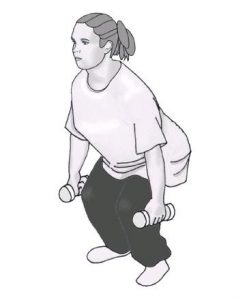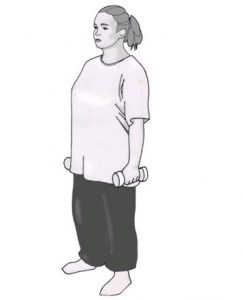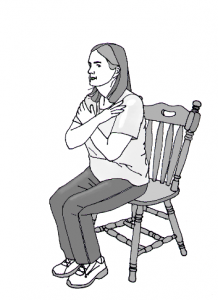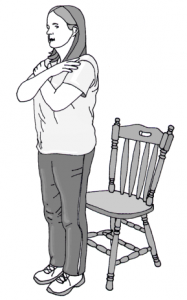5 Key Strengthening Exercises for People with Diabetes
Although stay-at-home restrictions are loosening around the USA and summer is coming, you may still need to get some of your activities indoors at home for a variety of reasons. If you aren’t doing resistance workouts already, you should really consider adding some resistance exercises to your normal regimens.
In fact, if you do nothing else, doing these 5 key exercises is critical for people with diabetes who may have weak core muscles, altered gait and balance, and central and peripheral nerve damage. If you lose your core strength, it will affect your ability to do all activities of daily living, including walking and living independently.
Do at least one set of 8-15 reps of each one, but work up to doing 2-3 sets of each one per workout. For best results, do these exercises at least 2 or 3 nonconsecutive days per week — muscles need a day or two off to fully recover and get stronger — but just don’t do them right before you go do another physical activity (as a fatigued core increases your risk of injury).
These and many more exercises are available on Diabetes Motion Academy for free download.
- Exercise 1: Crunches with waist worker
- Exercise 2: Chair sit-ups OR Low back strengthener
- Exercise 3: Modified push-ups
- Exercise 4: Squats OR Suitcase lifts
- Exercise 5: Sit-to-Stand exercise
#1: Crunches with waist worker
Crunches:
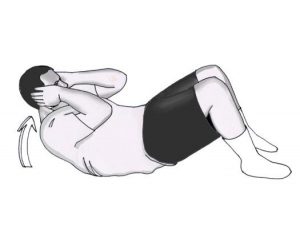
Directions:
- Lie down on your back with your knees bent.
- Place your hands on your head right behind your ears.
- While breathing out, contract your abdominal muscles to lift your head, neck, and shoulders off the floor and curl forward no more than 45 degrees.
- Hold for a moment before returning to the starting position, then repeat.
Waist worker:
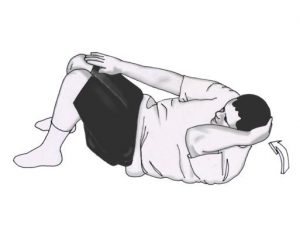
Directions:
- Lie on your back on the mat with your legs bent, your feet flat on the floor, and your left hand behind your head.
- Stretch your right hand across your body toward your opposite (left) knee and circle your hand three times around your knee in a counterclockwise direction; your right shoulder blade will lift off the mat.
- Repeat the circular movement around the right knee using your left arm, but in a clockwise motion.
- Keep your head in a neutral position and relax your neck to ensure that the contraction is in your abdomen area only.
#2: Chair sit-ups OR Low back strengthener
Chair sit-ups:
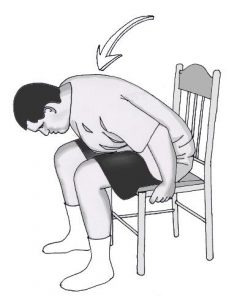
Directions:
- Sit up straight in a chair with your feet on the floor, hands to your sides for support.
- Bend forward, keeping your lower back as straight as possible, moving your chest down toward your thighs.
- Slowly straighten back up, using your lower back muscles to raise your torso.
- For added resistance, put a resistance band under both feet before you start and hold one end in each hand during the movement.
OR
Low back strengthener (Superman exercise):
Directions: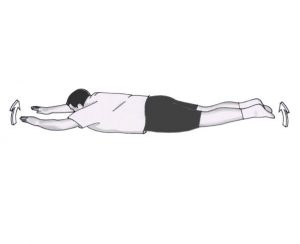
- Lie on your stomach with your arms straight over your head, your chin resting on the floor between your arms.
- Keeping your arms and legs straight, simultaneously lift your feet and your hands as high off the floor as you can (aim for at least three inches off the floor).
- Hold that position (sort of a Superman flying position) for 10 seconds if possible, and then relax your arms and legs back onto the floor.
- If this exercise is too difficult to start, try lifting just your legs or arms off the floor separately–or even just one limb at a time.
#3: Modified push-ups
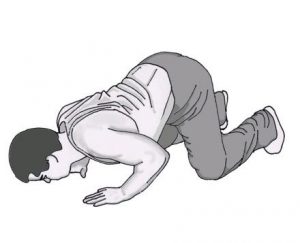
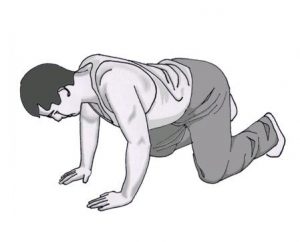
Directions:
- Get on your hands and knees on the floor or mat.
- If using a band for extra resistance, position it across your back and hold one end of it in each hand so that it is somewhat tight when your elbows are straight.
- Place your hands shoulder-width apart on the mat.
- Tighten your abdominal muscles to straighten your lower back and lower yourself (from your knees, not your feet) down toward the mat as far as you can without touching it.
- Push yourself back up until your arms are extended, but without locking your elbows.
- If this exercise is too hard, stand facing a wall and place your arms on it at shoulder height and your feet about a foot away; then, do your push-ups off the wall (with or without a resistance band).
#4: Squats OR Suitcase Lifts
Squats:
Directions:
- Stand with a dumbbell (or household item, like water bottles) in each hand and your feet shoulder-width apart, with your toes pointing slightly out to the side.
- If you’re using a resistance band, tie both ends of your band onto a straight bar or broom handle, which is placed squarely across your shoulders with the loop of the tied band placed under your feet.
- Keep your body weight over the back portion of your foot rather than your toes; if needed, lift your arms out in front of you to shoulder height to balance yourself.
- Begin squatting down but stop before your thighs are parallel to the floor (at about a 70-degree bend), keeping your back flat and your abdominal muscles firm at all times.
- Hold that position for a few seconds before pushing up from your legs until your body is upright in the starting position.
- Do squats with your back against a smooth wall if needed to maintain your balance.
OR
Suitcase lift:
Directions:
- After placing dumbbells (or household items) slightly forward and between your feet on the floor, stand in an upright position with your back straight.
- Keep your arms straight, with your hands in front of your abdomen.
- With your back straight, bend only your knees and reach down to pick up the dumbbells.
- Pick up the dumbbells or items in both hands, then push up with your legs and stand upright, keeping your back straight.
#5: Sit-to-Stand exercise
Directions:
- Sit toward the front of a sturdy chair and fold your arms across your chest.
- Keep your back and shoulders straight while you lean forward slightly and practice using only your legs to stand up slowly and to sit back down.
- To assist you initially, place pillows on the chair behind your low back.
From Diabetes Motion Academy Resources, “Basic Core Exercises,” Sheri R. Colberg © 2017.
Sheri R. Colberg, PhD, FACSM, is the author of The Athlete’s Guide to Diabetes: Expert Advice for 165 Sports and Activities (the newest edition of Diabetic Athlete’s Handbook), available through Human Kinetics, Amazon, Barnes & Noble, and elsewhere. She is also the author of Diabetes & Keeping Fit for Dummies. A professor emerita of exercise science from Old Dominion University and an internationally recognized diabetes motion expert, she is the author of 12 books, 30 book chapters, and over 420 articles. She was honored with the 2016 American Diabetes Association Outstanding Educator in Diabetes Award. Contact her via her websites, SheriColberg.com and DiabetesMotion.com.


